YAMAHA YFM700R 2021 Service Manual
Manufacturer: YAMAHA, Model Year: 2021, Model line: YFM700R, Model: YAMAHA YFM700R 2021Pages: 150, PDF Size: 3.63 MB
Page 41 of 150
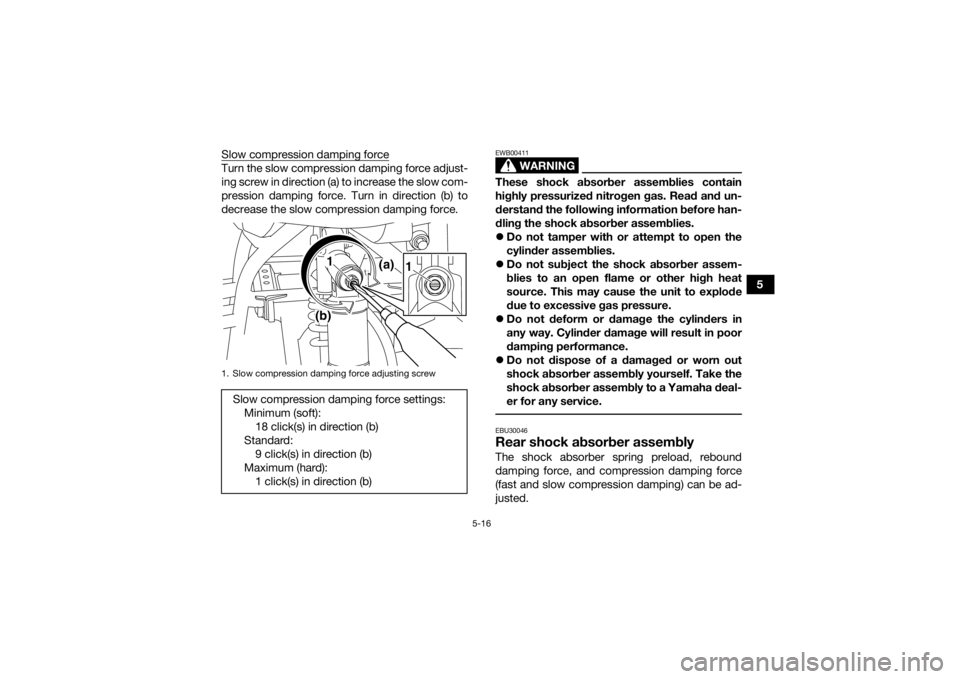
5-16
5
Slow compression damping force
Turn the slow compression damping force adjust-
ing screw in direction (a) to increase the slow com-
pression damping force. Turn in direction (b) to
decrease the slow compression damping force.
WARNING
EWB00411These shock absorber assemblies contain
highly pressurized nitrogen gas. Read and un-
derstand the following information before han-
dling the shock absorber assemblies.
Do not tamper with or attempt to open the
cylinder assemblies.
Do not subject the shock absorber assem-
blies to an open flame or other high heat
source. This may cause the unit to explode
due to excessive gas pressure.
Do not deform or damage the cylinders in
any way. Cylinder damage will result in poor
damping performance.
Do not dispose of a damaged or worn out
shock absorber assembly yourself. Take the
shock absorber assembly to a Yamaha deal-
er for any service. EBU30046Rear shock absorber assemblyThe shock absorber spring preload, rebound
damping force, and compression damping force
(fast and slow compression damping) can be ad-
justed.
1. Slow compression damping force adjusting screwSlow compression damping force settings:
Minimum (soft):18 click(s) in direction (b)
Standard: 9 click(s) in direction (b)
Maximum (hard): 1 click(s) in direction (b)
1 (a)
(b)
1
UBCX61E0.book Page 16 Friday, January 22, 2021 1:54 PM
Page 42 of 150
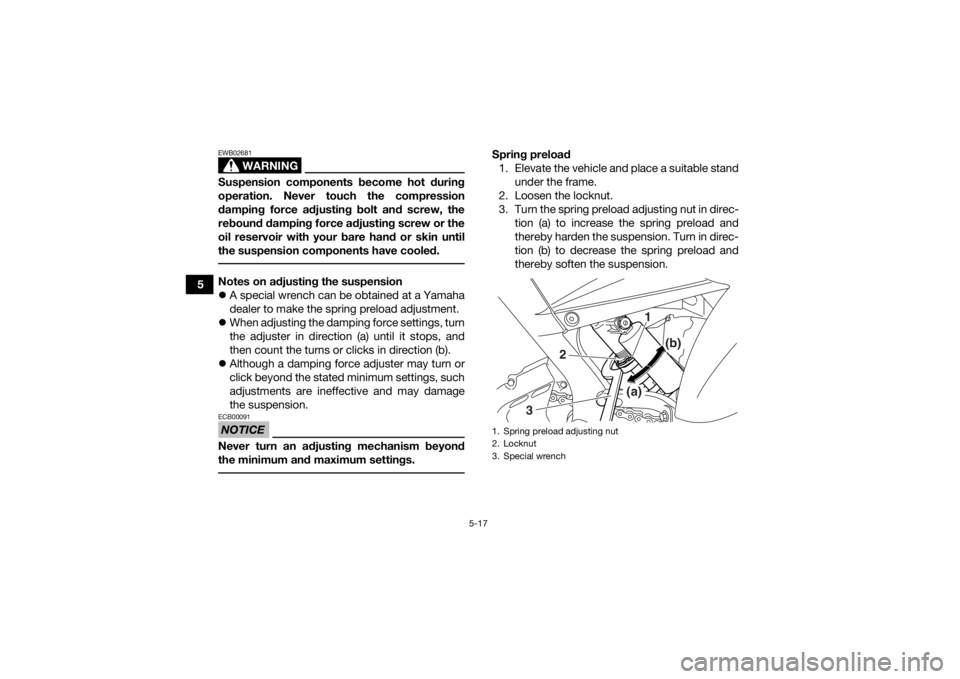
5-17
5
WARNING
EWB02681Suspension components become hot during
operation. Never touch the compression
damping force adjusting bolt and screw, the
rebound damping force adjusting screw or the
oil reservoir with your bare hand or skin until
the suspension components have cooled. Notes on adjusting the suspension
A special wrench can be obtained at a Yamaha
dealer to make the spring preload adjustment.
When adjusting the damping force settings, turn
the adjuster in direction (a) until it stops, and
then count the turns or clicks in direction (b).
Although a damping force adjuster may turn or
click beyond the stated minimum settings, such
adjustments are ineffective and may damage
the suspension.NOTICEECB00091Never turn an adjusting mechanism beyond
the minimum and maximum settings.
Spring preload
1. Elevate the vehicle and place a suitable stand under the frame.
2. Loosen the locknut.
3. Turn the spring preload adjusting nut in direc- tion (a) to increase the spring preload and
thereby harden the suspension. Turn in direc-
tion (b) to decrease the spring preload and
thereby soften the suspension.1. Spring preload adjusting nut
2. Locknut
3. Special wrench
1
(b)
(a)
2
3
UBCX61E0.book Page 17 Friday, January 22, 2021 1:54 PM
Page 43 of 150
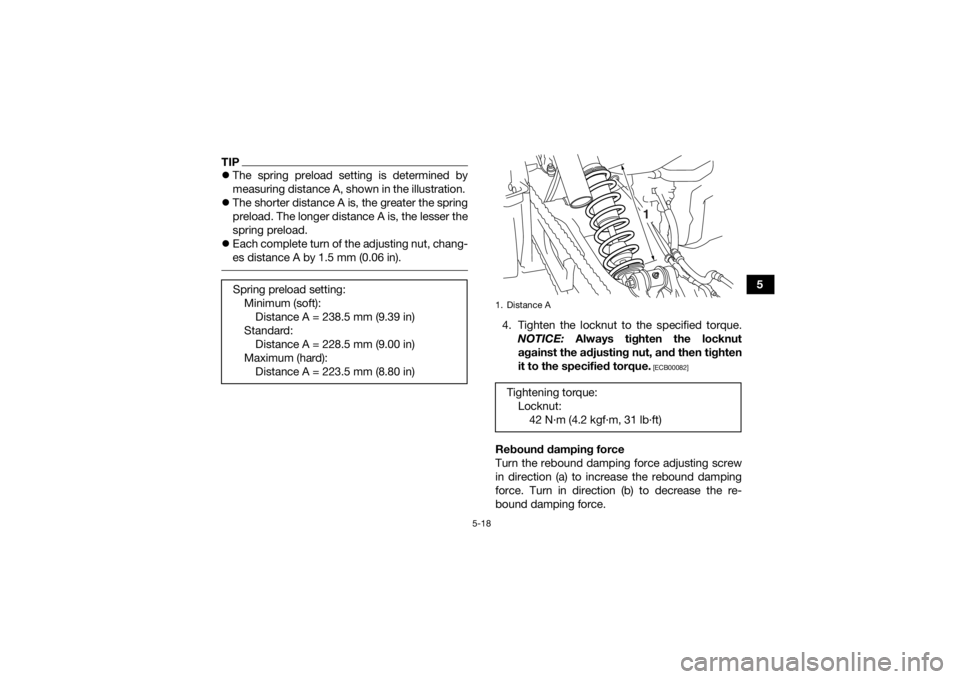
5-18
5
TIPThe spring preload setting is determined by
measuring distance A, shown in the illustration.
The shorter distance A is, the greater the spring
preload. The longer distance A is, the lesser the
spring preload.
Each complete turn of the adjusting nut, chang-
es distance A by 1.5 mm (0.06 in).
4. Tighten the locknut to the specified torque.
NOTICE: Always tighten the locknut
against the adjusting nut, and then tighten
it to the specified torque.
[ECB00082]
Rebound damping force
Turn the rebound damping force adjusting screw
in direction (a) to increase the rebound damping
force. Turn in direction (b) to decrease the re-
bound damping force.
Spring preload setting:
Minimum (soft):Distance A = 238.5 mm (9.39 in)
Standard: Distance A = 228.5 mm (9.00 in)
Maximum (hard): Distance A = 223.5 mm (8.80 in)1. Distance ATightening torque: Locknut:42 N·m (4.2 kgf·m, 31 lb·ft)
1
UBCX61E0.book Page 18 Friday, January 22, 2021 1:54 PM
Page 44 of 150
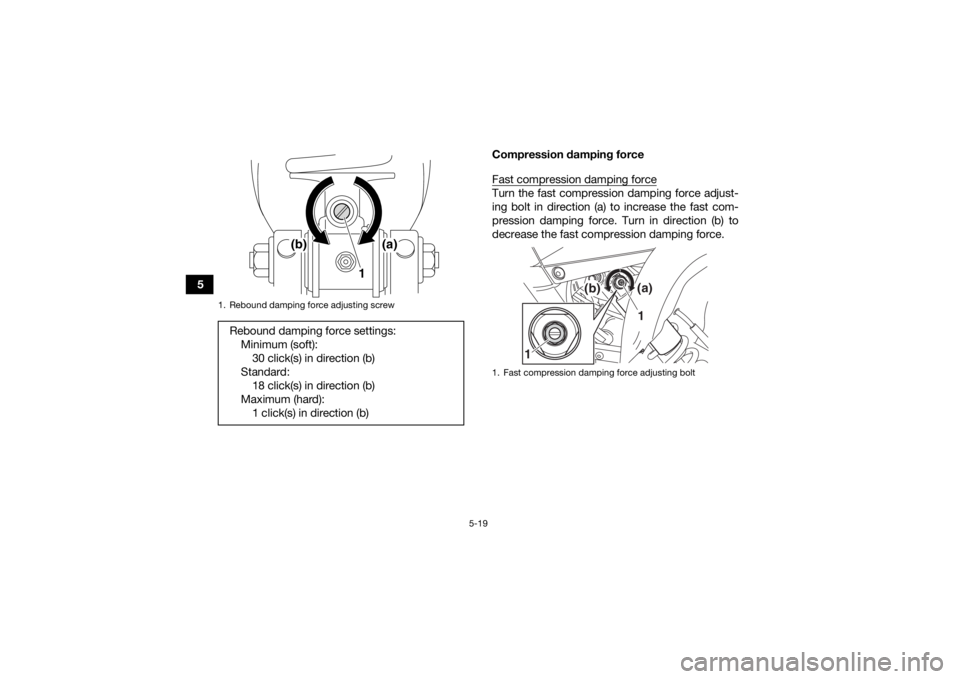
5-19
5Compression damping force
Fast compression damping force
Turn the fast compression damping force adjust-
ing bolt in direction (a) to increase the fast com-
pression damping force. Turn in direction (b) to
decrease the fast compression damping force.
1. Rebound damping force adjusting screwRebound damping force settings:
Minimum (soft):30 click(s) in direction (b)
Standard: 18 click(s) in direction (b)
Maximum (hard): 1 click(s) in direction (b)
1
(b) (a)
1. Fast compression damping force adjusting bolt
1
(b)
(a)
1
UBCX61E0.book Page 19 Friday, January 22, 2021 1:54 PM
Page 45 of 150
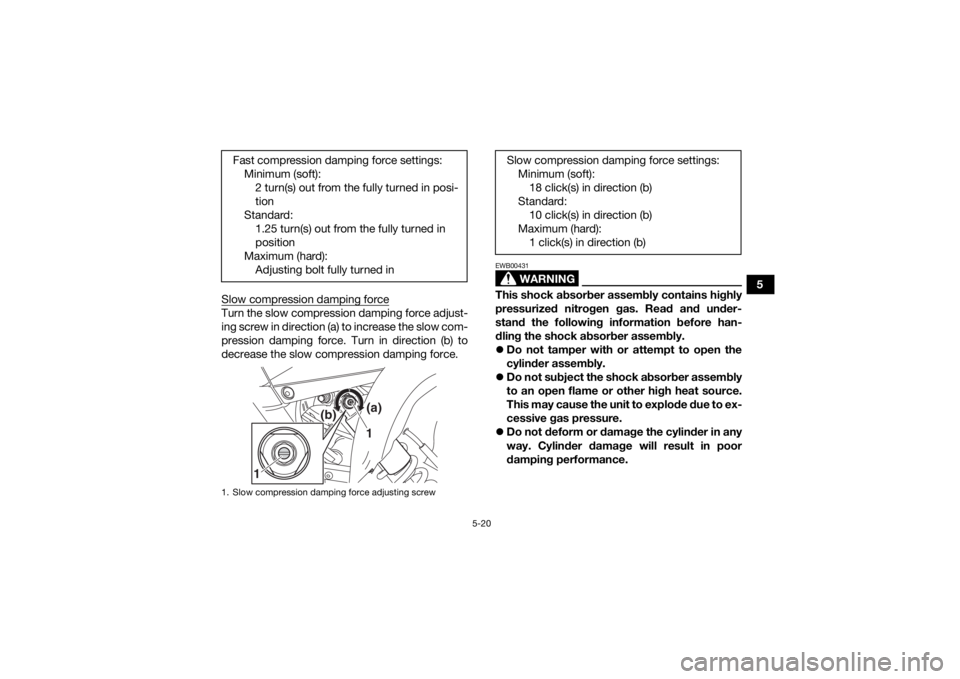
5-20
5
Slow compression damping force
Turn the slow compression damping force adjust-
ing screw in direction (a) to increase the slow com-
pression damping force. Turn in direction (b) to
decrease the slow compression damping force.
WARNING
EWB00431This shock absorber assembly contains highly
pressurized nitrogen gas. Read and under-
stand the following information before han-
dling the shock absorber assembly.
Do not tamper with or attempt to open the
cylinder assembly.
Do not subject the shock absorber assembly
to an open flame or other high heat source.
This may cause the unit to explode due to ex-
cessive gas pressure.
Do not deform or damage the cylinder in any
way. Cylinder damage will result in poor
damping performance.
Fast compression damping force settings:
Minimum (soft):2 turn(s) out from the fully turned in posi-
tion
Standard: 1.25 turn(s) out from the fully turned in
position
Maximum (hard): Adjusting bolt fully turned in
1. Slow compression damping force adjusting screw
1
(b)
(a)
1
Slow compression damping force settings:
Minimum (soft):18 click(s) in direction (b)
Standard: 10 click(s) in direction (b)
Maximum (hard): 1 click(s) in direction (b)
UBCX61E0.book Page 20 Friday, January 22, 2021 1:54 PM
Page 46 of 150

5-21
5
Do not dispose of a damaged or worn out
shock absorber assembly yourself. Take the
shock absorber assembly to a Yamaha deal-
er for any service.
UBCX61E0.book Page 21 Friday, January 22, 2021 1:54 PM
Page 47 of 150
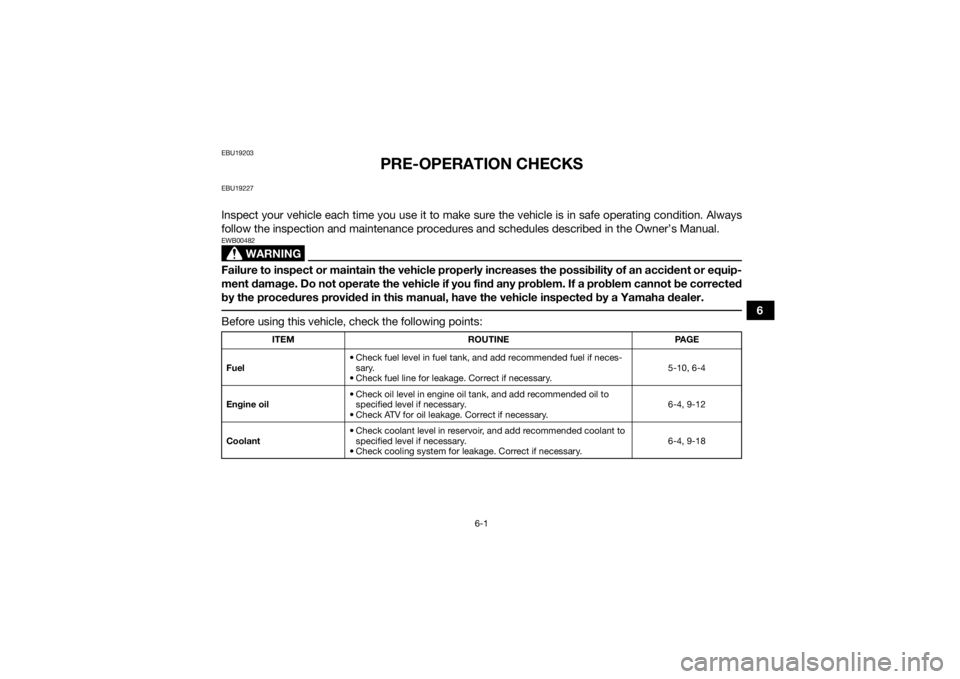
6-1
6
EBU19203
PRE-OPERATION CHECKS
EBU19227Inspect your vehicle each time you use it to make sure the vehicle is in safe operating condition. Always
follow the inspection and maintenance procedures and schedules described in the Owner’s Manual.
WARNING
EWB00482Failure to inspect or maintain the vehicle properly increases the possibility of an accident or equip-
ment damage. Do not operate the vehicle if you find any problem. If a problem cannot be corrected
by the procedures provided in this manual, have the vehicle inspected by a Yamaha dealer. Before using this vehicle, check the following points:
ITEMROUTINE PAGE
Fuel • Check fuel level in fuel tank,
and add recommended fuel if neces-
sary.
• Check fuel line for leakage. Correct if necessary. 5-10, 6-4
Engine oil • Check oil level in engine oil tank, and add recommended oil to
specified level if necessary.
• Check ATV for oil leakage. Correct if necessary. 6-4, 9-12
Coolant • Check coolant level in reservoir, and add recommended coolant to
specified level if necessary.
• Check cooling system for leakage. Correct if necessary. 6-4, 9-18
UBCX61E0.book Page 1 Friday, January 22, 2021 1:54 PM
Page 48 of 150

6-2
6
Front brake• Check operation. If soft or spongy, have Yamaha dealer bleed hy-
draulic system.
• Check brake pads for wear, and replace if necessary.
• Check brake fluid level in reservoir, and add specified brake fluid to specified level if necessary.
• Check hydraulic system for leakage. Correct if necessary. 6-4, 9-29, 9-30, 9-33
Rear brake • Check operation. If soft or spongy, have Yamaha dealer bleed hy-
draulic system.
• Check brake pads for wear, and replace if necessary.
• Check brake fluid level in reservoir, and add specified brake fluid to specified level if necessary.
• Check hydraulic system for leakage. Correct if necessary. 6-4, 9-29, 9-30, 9-34
Clutch • Check operation, and correct if necessary.
• Lubricate cable if necessary.
• Check lever free play, and adjust if necessary. 9-36
Throttle lever • Make sure that operation is smooth. Lubricate cable and lever
housing if necessary.
• Check lever free play, and adjust if necessary. 6-5, 9-28
Control cables • Make sure that operation is smooth. Lubricate if necessary. 9-40
Drive chain • Check chain slack, and adjust if necessary.
• Check chain condition. Lubricate if necessary. 6-5, 9-38, 9-40
Wheels and tires • Check wheel condition, and replace if damaged.
• Check tire condition and tread depth. Replace if necessary.
• Check air pressure. Correct if necessary. 6-5
Shift pedal • Make sure that operation is smooth.
• Correct if necessary.
9-41
Brake pedal • Make sure that operation is smooth. Lubricate pedal pivoting point
if necessary. 9-41
ITEM ROUTINE PAGEUBCX61E0.book Page 2 Friday, January 22, 2021 1:54 PM
Page 49 of 150

6-3
6
Brake and clutch levers• Make sure that operation is smooth. Lubricate lever pivoting points
if necessary. 9-41
Chassis fasteners • Make sure that all nuts, bolts and screws are properly tightened. 6-7
Instruments, lights and
switches • Check operation, and correct if necessary.
6-7
ITEM
ROUTINE PAGE
UBCX61E0.book Page 3 Friday, January 22, 2021 1:54 PM
Page 50 of 150
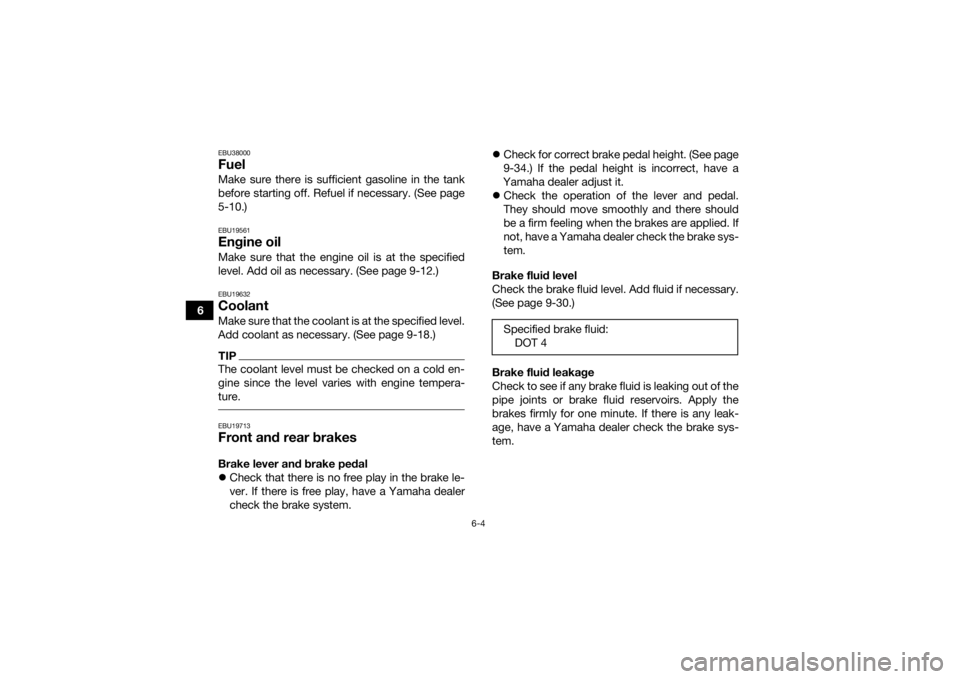
6-4
6
EBU38000FuelMake sure there is sufficient gasoline in the tank
before starting off. Refuel if necessary. (See page
5-10.)EBU19561Engine oilMake sure that the engine oil is at the specified
level. Add oil as necessary. (See page 9-12.)EBU19632CoolantMake sure that the coolant is at the specified level.
Add coolant as necessary. (See page 9-18.)TIPThe coolant level must be checked on a cold en-
gine since the level varies with engine tempera-
ture. EBU19713Front and rear brakesBrake lever and brake pedal
Check that there is no free play in the brake le-
ver. If there is free play, have a Yamaha dealer
check the brake system.
Check for correct brake pedal height. (See page
9-34.) If the pedal height is incorrect, have a
Yamaha dealer adjust it.
Check the operation of the lever and pedal.
They should move smoothly and there should
be a firm feeling when the brakes are applied. If
not, have a Yamaha dealer check the brake sys-
tem.
Brake fluid level
Check the brake fluid level. Add fluid if necessary.
(See page 9-30.)
Brake fluid leakage
Check to see if any brake fluid is leaking out of the
pipe joints or brake fluid reservoirs. Apply the
brakes firmly for one minute. If there is any leak-
age, have a Yamaha dealer check the brake sys-
tem. Specified brake fluid:
DOT 4UBCX61E0.book Page 4 Friday, January 22, 2021 1:54 PM